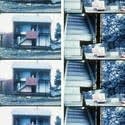Films: GORDON MATTA-CLARK
-
Introduction
On Friday, 4th of April 2014, Galerie Thomas Schulte will host the opening of Gordon Matta-Clark’s exhibition Films, which marks the seventh show of the artist in the gallery since 1994 and the second one dedicated to his films. The presented works cover the short but extensive oeuvre of the late Gordon Matta-Clark that elevated him as one of the most important figures of the art scene of the 70s, both in the United States and in Europe.
The child of the surrealist painter, Roberto Matta, Gordon Matta-Clark was trained as an architect. Living and working in the Soho area of downtown Manhattan, the artist developed a unique style that relied both on art historian awareness and the influence of philosophical ideas, such as that of the Situationists or of artistic movements like Conceptualism and Land Art. His interest in public and private spheres, urban landscapes and architectural spaces helped him to elaborate his own artistic praxis – producing sculptures, drawings, photographs, performances and films, even though he was uninhibited by any formal training in the latter.
Although Matta-Clark is mainly known for his “cut pieces” he executed in the US and in Europe, for example in Antwerp or Paris, the films exhibited in Galerie Thomas Schulte show a wider range of interventions he made in urban spaces, often in collaboration with other artists, dancers, and friends, thus, creating a communal experience in some works. However, one can see the coherence of his oeuvre, and can be fascinated by certain reoccurring elements and tools of the artist that connect the pieces together and invite us to contemplate the importance of similarities. Ropes, pipes, towers, nets, holes, height, and depth become crucial parts of Matta-Clark’s iconography and reflect the holistic character of his work.
The gesture of cutting in Splitting or Office Baroque can also be observed in more experimental films like City Slivers or Automation House, where the medium of film undergoes a similar kind of vertical modification, dividing the picture into different perspectives. The films, showing the expedition of the artist into the underground world of subway tunnels, crypts, and sewers of New York and Paris, counterpart the aerial, stunt-like performances of Clockshower or Tree Dance. Aside from the archaeological scrutiny, the subdivision of urban space in public and private spheres is also addressed in films, such as Chinatown Voyeur or Open House. Matta-Clark derived one of his central artistic interests by challenging the social terms of the “inside” and the “outside” through spatial alternation (either in transgressive acts or by sculptural interventions in the architectural landscape) and through the explorations into the depth of the city.
The films on display are not merely by-products of the performances and sculptural interventions of the artist. Apart from the undeniable documentary-like nature of some of the films and their ability to represent the procedural and narrative character of Matta-Clark’s acts, they convey their own artistic qualities. During the twenty-minute long, low quality shot of Day’s End, sunlight sweeps into the huge, derelict pier Gordon Matta-Clark used for his “cut piece” at Hudson River. The camera is sometimes blinded by the sunlight or captures its gleam mirrored by the river. Despite simply depicting the two month long process of creating the work, the film is ultimately a lyrical account that uses painterly effects to augment our understanding of the sculpture’s spatial and temporal dimension. By doing so, the film proves to be a paramount instrument in fully understanding Gordon Matta-Clark’s extraordinary work.
-
Installation Views
-
Works
-
Inquire about works by Gordon Matta-Clark

-
Artists on view


















